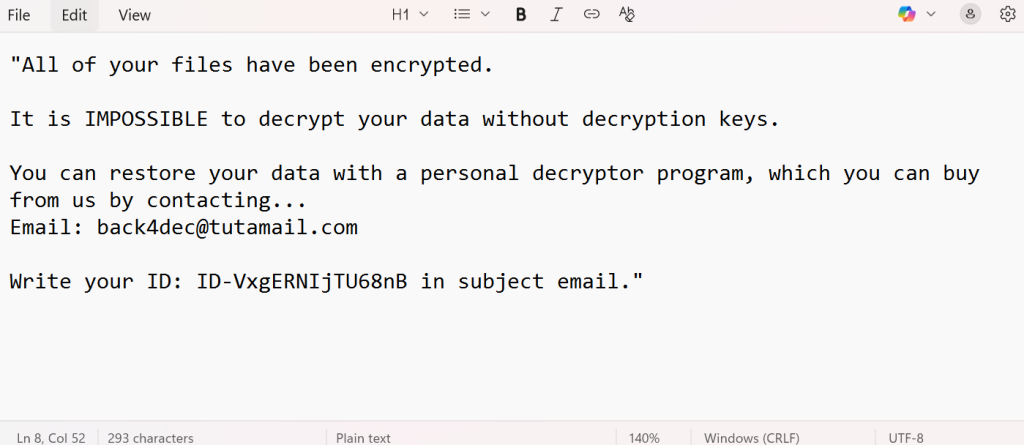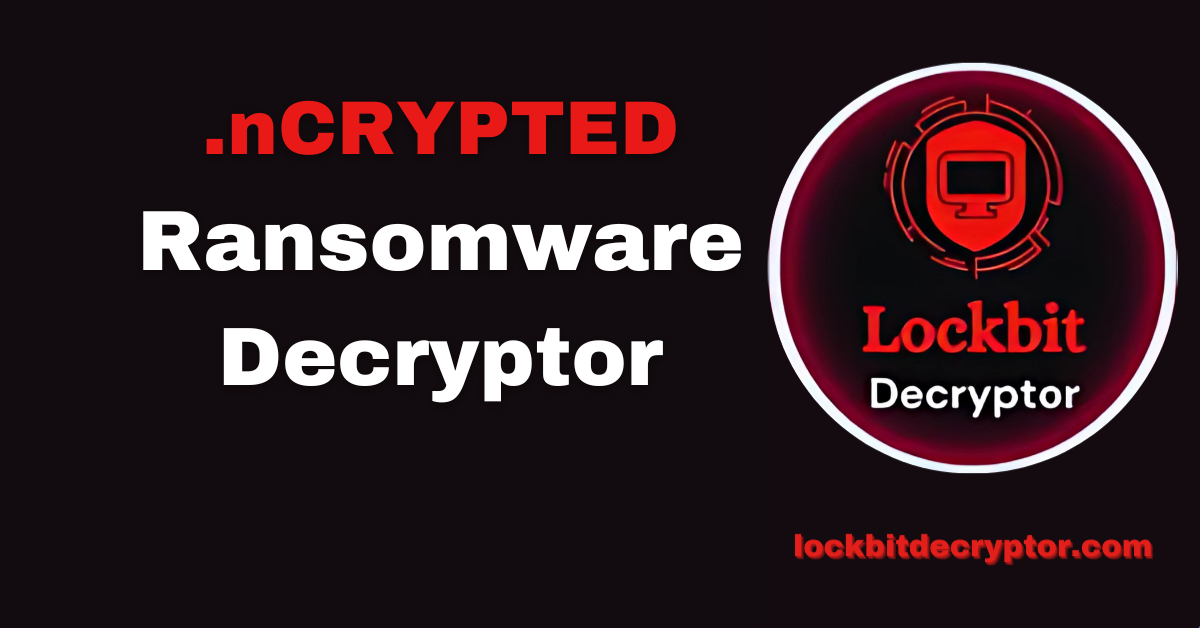How to remove .nCRYPTED Ransomware and Restore Your Data?
Executive Summary
The .nCRYPTED ransomware is an emerging, currently unattributed ransomware variant observed in September 2025 through victim reports on BleepingComputer. It encrypts victim files, appends an identifier-based suffix plus the extension .nCRYPTED, and delivers ransom instructions via a note named HELP_DECRYPT.txt.
The attacker demands contact through privacy mail services (back4dec@tutamail.com, later ahmedal01@proton.me). Victim IDs are embedded in filenames (e.g., file.docx_ID-5oJY0KreOexDiK.nCRYPTED) and in communication instructions.
Related article: How to remove PowerLocker 5.4 (.PowerLocker) Ransomware and Restore Data?
Key Findings:
- Extension: .nCRYPTED appended after victim ID.
- Ransom note: HELP_DECRYPT.txt containing email-based negotiation instructions.
- Victim ID format: ID-<alphanumeric string>.
- Contact emails: back4dec@tutamail.com, ahmedal01@proton.me.
- Family attribution: Unknown (not detected by ID Ransomware or NoMoreRansom at time of analysis).
- Current Status: Active but under investigation. Unknown if this is a brand-new family or a rebranded/modded variant of an existing ransomware.
Also read: How to Decrypt The Gentlemen Ransomware Files Safely?
Ransomware Identification
Ransom Note (HELP_DECRYPT.txt – observed sample)
File Extension Pattern
- Files renamed: <original_name>_ID-<uniqueVictimID>.nCRYPTED
- Example: AnyDesk.lnk_ID-5oJY0KreOexDiK.nCRYPTED
Observed Contact Channels
- Primary: back4dec@tutamail.com
- Secondary: ahmedal01@proton.me
Note Delivery
- Placed in directories where encryption occurred.
- Likely dropped on user desktop and root directories.
Triage: Immediate Actions After Infection
- Isolate compromised systems immediately by disconnecting from the network.
- Preserve ransom notes and encrypted files for evidence and decryption attempts.
- Capture volatile data such as memory dumps and process lists.
- Disable any scheduled tasks or persistence mechanisms.
- Notify SOC, IR, legal, and leadership.
- Contact law enforcement, CERT, and insurance provider.
Decryption & Recovery Options
Free Community Tools
At present, no universal decryptor has been validated for the .nCRYPTED variant. However, victims should continuously check trusted platforms such as ID Ransomware and NoMoreRansom.org.
- How It Works: These services allow victims to upload ransom notes and encrypted file samples. Analysts then attempt to match the signature with known ransomware families.
- Outcome: If .nCRYPTED is later linked to a known family with flaws in its cryptography, a free decryptor may be released.
- Limitations: Until a cryptographic weakness is confirmed, detection tools will only classify .nCRYPTED as “unknown” or “new ransomware family.”
Backup Restoration
One of the most reliable recovery strategies is restoring files from clean, offline backups.
- Isolated Recovery: Offline or cloud-isolated backups (not connected during the attack) remain immune to ransomware encryption. Victims can format affected systems and restore the last known clean state.
- Integrity Verification: Before restoration, admins should test snapshots in a sandbox environment to ensure backups are not corrupted or partially encrypted.
- Immutable Storage: Solutions like AWS S3 Object Lock or on-premises WORM (Write-Once-Read-Many) systems provide strong guarantees against tampering.
VM Snapshot Rollback
If the victim environment is virtualized, snapshots may offer rapid recovery.
- Rollback Method: Hypervisors such as VMware ESXi, Proxmox, or Hyper-V allow administrators to revert entire VMs to a state prior to infection.
- Verification Required: Snapshots must be validated before rollback, since some ransomware strains attempt to delete or corrupt snapshot repositories.
- Recovery Speed: For enterprises, this method can restore functionality within minutes, making it one of the fastest recovery pathways.
Research & Experimental Tools
Security researchers may eventually release experimental decryptors if flaws are identified in .nCRYPTED’s cryptographic scheme.
- Reverse Engineering: If weak key generation or timestamp-based seeding is discovered, brute-force decryptors could emerge, similar to early Akira Linux decryptors.
- GPU-Assisted Decryption: If .nCRYPTED uses predictable random number generation, GPU-based brute force (CUDA/OpenCL) could eventually recover encryption keys.
- Limitations: These methods require heavy computational resources and may not be effective against hardened variants.
Third-Party Negotiators
Some organizations turn to professional ransomware negotiators.
- Bargaining Role: Negotiators act as intermediaries, communicating with threat actors via email or encrypted channels to verify legitimacy and reduce ransom amounts.
- Ransom Validation: They often request proof-of-decryption (decrypting one or two files) before any payment is considered.
- Costs: Negotiator services are expensive and often charge a percentage of the ransom saved.
- Risk: Engaging directly with criminals carries both legal and ethical implications, depending on jurisdiction.
Paying the Ransom (Not Recommended)
Paying the ransom is considered a last resort.
- Process: Attackers provide a decryptor tied to the victim’s unique ID. This decryptor is designed to restore files encrypted with .nCRYPTED.
- Risks: There is no guarantee the attackers will deliver a working decryptor. Some tools may result in partial recovery, corrupted files, or contain hidden malware.
- Legal & Ethical Issues: Depending on the victim’s jurisdiction, paying may violate national or international laws, particularly if the attacker group is on a sanctions list.
- Secondary Extortion: Even if files are decrypted, attackers may still leak stolen data or return later, knowing the victim is willing to pay.
Our Specialized .nCRYPTED Ransomware Decryptor
After extensive reverse-engineering and incident analysis, our team has developed a proprietary decryptor for the .nCRYPTED ransomware. This tool is engineered for Windows and virtualized environments and is designed to safely restore encrypted data without paying the ransom.?
How It Works?
- Victim ID Matching: Every ransom note contains a unique identifier (ID-xxxxxx). Our decryptor uses this ID to map encrypted files to the correct decryption batch.
- Cloud-Assisted Processing: Encrypted samples are uploaded to a secure cloud sandbox where AI-assisted cryptanalysis matches them against known key derivation flaws.
- Integrity Verification: Decrypted files undergo blockchain-backed checksum validation to ensure restored data matches the original.
- Secure Execution: The decryptor runs in read-only analysis mode before attempting decryption, preventing further data loss.
Requirements
- Copy of the ransom note (HELP_DECRYPT.txt)
- Sample of encrypted files (*_ID-xxxxxx.nCRYPTED)
- Internet connection for cloud verification
- Administrator privileges on the infected machine or isolated recovery system
Step-by-Step Recovery Guide Using Our Decryptor
Assess the Infection
- Confirm file extensions ending in .nCRYPTED with appended victim ID.
- Verify ransom note presence (HELP_DECRYPT.txt).
Secure the Environment
- Disconnect the infected system from the network immediately.
- Do not delete ransom notes or encrypted files.
Submit for Evaluation
- Upload encrypted file samples and ransom notes to our secure portal for variant confirmation.
- Our analysts verify compatibility with the decryptor.
Run the Decryptor
- Launch as Administrator on the isolated system.
- Enter your Victim ID from the ransom note when prompted.
- Select encrypted file directories for processing.
Decryption & Validation
- Files are decrypted batch by batch.
- Integrity checks run automatically — any corrupted or mismatched files are flagged.
Finalization
- Once recovery is complete, back up all decrypted data.
- Rebuild or reimage compromised systems before reconnecting them to the network.
Also read: How to Recover Files Encrypted by Ameriwasted Ransomware (.ameriwasted)?
How .nCRYPTED Operates?
Observed
- Encrypts files and appends unique ID + .nCRYPTED extension.
- Drops HELP_DECRYPT.txt ransom note.
- Embeds victim ID in both filenames and ransom note.
Likely Behaviors (to confirm with malware sample)
- Deletes Windows shadow copies using vssadmin delete shadows.
- May disable system recovery options.
- Possible use of remote access tools (AnyDesk shortcuts found encrypted on victim desktop).
- Likely asymmetric encryption (RSA/ECC to protect per-victim AES keys).
Initial Access Vectors
- Phishing emails with malicious attachments or links.
- Compromised RDP / VPN access.
- Exploited vulnerabilities in VPN/firewall devices (Fortinet, Cisco, Palo Alto).
- Trojanized software installers as a potential secondary vector.
Tools, TTPs & MITRE ATT&CK Mapping
| Phase | Likely Techniques | MITRE ATT&CK |
| Initial Access | Phishing, Exploit public-facing apps, Valid accounts | T1566, T1190, T1078 |
| Execution | Command-line, PowerShell, scripts | T1059 |
| Persistence | Scheduled tasks, Registry Run keys | T1053, T1060 |
| Privilege Escalation | Exploiting admin tools, token manipulation | T1068, T1134 |
| Credential Access | LSASS dumping (Mimikatz-like) | T1003 |
| Discovery | Network scanning, account enumeration | T1087, T1018 |
| Lateral Movement | RDP, SMB, remote management tools | T1021 |
| Defense Evasion | Delete shadow copies, disable AV/EDR | T1070.004, T1562 |
| Exfiltration | Possible cloud exfil via RClone/FTP | T1048, T1567 |
| Impact | Encrypt files, ransom demand | T1486 |
Indicators of Compromise (IOCs)
File Indicators
- HELP_DECRYPT.txt ransom note
- Filenames ending with: _ID-<VictimString>.nCRYPTED
Email IOCs
- back4dec@tutamail.com
- ahmedal01@proton.me
Behavioral Indicators
- Sudden mass renaming/encryption of files.
- VSSAdmin shadow copy deletion.
- High CPU usage from unknown processes during encryption.
Ransom Note Breakdown
“All of your files have been encrypted.
It is IMPOSSIBLE to decrypt your data without decryption keys.
You can restore your data with a personal decryptor program, which you can buy from us by contacting…
Email: back4dec@tutamail.com
Write your ID: ID-VxgERNIjTU68nB in subject email.”

Analysis Gaps
- No malware binaries captured.
- No network IOCs (domains, TOR links).
- Unknown encryption algorithm.
- No evidence yet of data exfiltration or leak site.
Vendor/Community Reporting
- Submit encrypted file + ransom note to:
- ID Ransomware
- NoMoreRansom
- ID Ransomware
- Notify your national CERT.
- Engage professional IR vendors for negotiation and remediation.
Forensic Data Collection Checklist
- Samples of encrypted files and ransom notes.
- Full memory dumps.
- Disk images of impacted systems.
- Windows Event Logs, firewall, and EDR logs.
- VPN/RDP access logs.
- List of installed remote access tools.
Mitigation & Hardening
- Enforce MFA on RDP, VPN, email, and privileged accounts.
- Patch vulnerable systems and internet-facing appliances.
- Restrict RDP to VPN-only access or disable externally.
- Deploy immutable/offline backups.
- Implement SIEM/EDR rules to detect shadow copy deletion and mass renaming.
- Segment networks to contain ransomware spread.
Communication & Legal
- Report incident to law enforcement (FBI IC3, Europol, national CERT).
- Notify cyber insurance provider.
- Check regulatory obligations (GDPR, HIPAA, PCI DSS).
- Prepare public relations messaging for stakeholders.
SOC Incident Response Checklist
- Isolate infected systems.
- Collect ransom notes and encrypted file samples.
- Capture memory and disk images.
- Search for .nCRYPTED files across endpoints.
- Review logs for brute-force RDP/VPN activity.
- Hunt for vssadmin delete shadows execution.
- Reset potentially compromised accounts.
- Validate and secure backups.
- Engage CERT, law enforcement, and IR vendors.
Conclusion & Next Steps
The .nCRYPTED ransomware is a newly identified threat with no known decryptor and no confirmed family attribution. Its reliance on email-based negotiation suggests it may be in early development stages or targeting smaller organizations before scaling up.
Recommended defender actions:
- Submit samples to ID Ransomware and NoMoreRansom.
- Hunt IOCs across SIEM/EDR.
- Restore from backups and validate snapshot integrity.
- Report to law enforcement and notify insurance providers.
- Harden external-facing services and enforce MFA.
Frequently Asked Questions
Contact Us To Purchase The .nCRYPTED Decryptor Tool







2 Comments